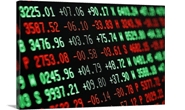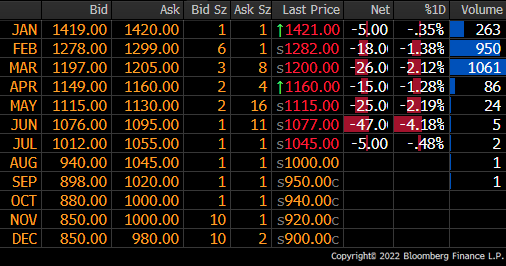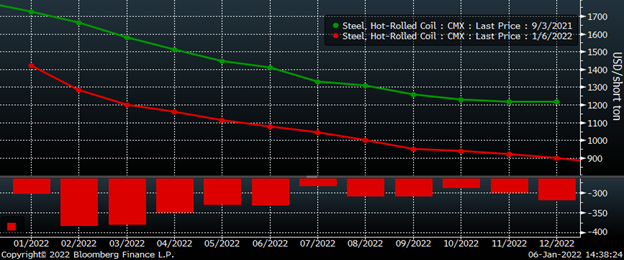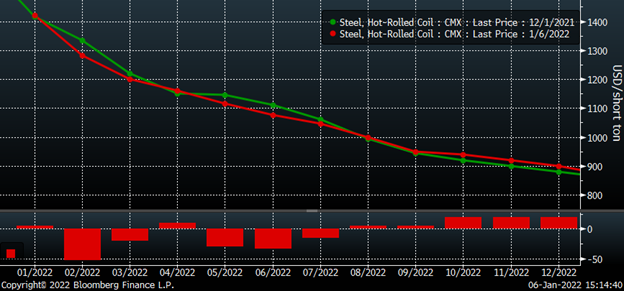Futures

Ferrous Futures: HRC & Bus Volumes Surge to Open ‘22
Written by David Feldstein
December 9, 2021
Editor’s note: SMU Contributor David Feldstein is president of Rock Trading Advisors. Rock provides customers attached to the steel industry with commodity price risk management services and market intelligence. RTA is registered with the National Futures Association as a Commodity Trade Advisor. David has over 20 years of professional trading experience and has been active in the ferrous derivatives space since 2012.
There is no doubt that winter has come. The bear is up and the bear is angry. The December CME future settled down $183 MoM at $1,616/st. December’s decline set a new MoM absolute change record going back to at least 2010. Open interest across all HRC futures set a new all-time record as well at 871,320 short tons. This continues to be a technically strong bear market.
In the chart below the red line is the aggregate open interest across all futures with the yellow dotted line a 22-day moving average.
Rolling 2nd Month CME HR Future $/st & Open Interest (red)

The reliable back half of December slow down for the industry occurred once again as the supply chain broke apart for much needed vacations after one of the most intense years ever. The HRC futures market was also very quiet throughout December with a number of market participants, especially the noncommercial ones, having closed out their books for the year. The first couple of days of 2022 started out slow, but picked up today with just under 48k tons trading (each contract is 20 tons).
CME Hot Rolled Coil Futures

The HRC futures market peaked in early September. This chart shows the curve’s settlements on Sept. 3 and today with the change for each month shown in the panel below. Since September, February and March have declined by the most, around $380 each.
CME Hot Rolled Coil Futures Curve $/st

The rapid shift in steel fundamentals may have left those suffering from recency bias flat footed. The lack of availability that plagued the industry throughout most of 2021 is no more. In fact, fundamentals indicate steel is now oversupplied. HR lead times have fallen from eight to four weeks, service center inventory has been replenished and the spike in imports, shown below, will likely continue for months.
Imports – Flat Rolled Sheet (HR, CR, HDG & Galv)

Since the start of December, there really hasn’t been much change to the curve. February has declined by $50, but considering how much new information has been learned, does the curve know something we don’t? Unfortunately, the answer is no. The curve is simply the price point at which two market participants agree to trade. Just look at the curve on Sept. 3 and ask yourself how smart the curve was that day.
CME Hot Rolled Coil Futures Curve $/st

The January ’21 future first traded $1,000 on Dec. 16, 2020. At that time, lead times were at eight weeks, now they are four; 425k tons of the four flat rolled sheet products were imported in Nov. ’20 versus 1.13m in Nov. ’21; and service center flat rolled inventory has increased by almost 1m tons YoY. Last Jan. 6, the January ’21 HRC future settled at $1,053. Today, the January ’22 future settled at $1,421.
“And they’re certainly not showing, any signs that they are slowing.” Willy Wonka
CME busheling futures have seen a spike in open interest over the past month, closing last night at 95,240 tons with OI clearly breaking above its down trend. Price trending lower while open interest is increasing qualifies busheling to be in a technically strong bear market.
Rolling Second Month CME Busheling Future $/lt & Open Interest

Let’s get technical. The rolling 2nd month busheling future (February) has developed into a textbook “head and shoulders” pattern, which is used to identify a trend reversal. The head in the middle and shoulders on each side are indicated by the red arcs while the neckline, shown by the yellow dotted line, provides support. If trading breaks below the neckline or support level, especially if it is followed with heavy volume, then a sharp sell-off is likely to follow. Google it. Earlier today starting just after 1:30 p.m. CST, 80 tons of February bus traded at $570 followed by 100 tons at $565. Another hundred tons traded at $560. While that is not what I consider to be significant volume, it’s all relative and busheling is a rather illiquid product. Regardless, keep an eye on busheling futures in the coming days to see if there is any follow through the $580 level on the H&S pattern.
Rolling Second Month CME Busheling Future

Disclaimer: The content of this article is for informational purposes only. The views in this article do not represent financial services or advice. Any opinion expressed by Feldstein should not be treated as a specific inducement to make a particular investment or follow a particular strategy, but only as an expression of his opinion. Views and forecasts expressed are as of date indicated, are subject to change without notice, may not come to be and do not represent a recommendation or offer of any particular security, strategy or investment. Strategies mentioned may not be suitable for you. You must make an independent decision regarding investments or strategies mentioned in this article. It is recommended you consider your own particular circumstances and seek the advice from a financial professional before taking action in financial markets.

David Feldstein
Read more from David FeldsteinLatest in Futures

HR Futures: Oil, Mideast tensions fail to move steel
After a hot start to June, the CME ferrous derivatives complex has cooled down.

HRC Futures: Could oil, ag price spikes drive steel higher too?
Could we see an abrupt shift now that oil prices have spiked higher? Will we see a rebound in the rig count? Will this create a snap-loading effect (think waterski rope), where the industry suddenly does a 180-degree turn? If so, will that bring with it increased demand for steel products used by the energy industry?

Flack: HR futures still on a wild ride
Never a dull moment in today's HR futures market.

Tariff announcement upends futures market
A fierce flat price rally started this week that saw the nearby months rally by over $120/ short tons, exceeding the contract highs seen in February ahead of the first batch of tariffs.

HR futures remain sensitive to tariff talk
The speed and scale of recent moves are reminders of just how sensitive HRC futures remain to structural shifts and sentiment cues.
